The country that could shoot down the SR-71
It was under this heading This Country Almost Shot Down the SR-71 Blackbird that an article appeared in The National Interest, widely known in narrow circles, and caught my eye.
To my great surprise, it turned out that this country was not even the USSR at all, but Sweden.
TNI, in turn, politely referred to several sources, and eventually I came across several books by one Paul Crickmor, who seemed to have researched quite thoroughly history creation and use of this amazing aircraft.
All books are offered on Amazon for $30-$35, but we're not that generous and the internet is such a thing...
In general, as a result, I can report the following.
difficult target
In the 1980s, at the height of the Cold War, Swedish pilots flew 400-500 times a year to intercept unidentified aircraft. The country was neutral, it was true, but it really did not like it when someone - no matter who - approached its borders.
Such encroachments occurred both from the Warsaw Pact countries and from the NATO countries, and the SR-71 was the most difficult target for the Swedish pilots.
At that time, this machine regularly, once a week, flew along the route of the so-called "Baltic Express", and the Swedes could not help but take this opportunity to train and gain experience in intercepting ultra-fast and super-high targets.
Since the Drozd tried not to cross anyone's borders without obvious need, its route, among other things, ran through a narrow corridor of neutral space between the islands of Gotland and Oland, and it was there that the Swedish pilots tried to intercept it over and over again. Of course, in jest.
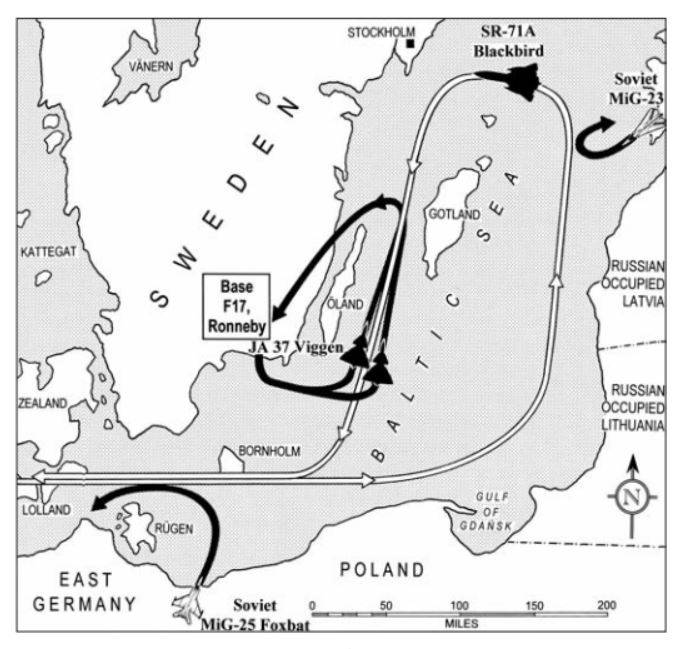
For the time being, at best, they could only notice a dark dot that flickered in the distance. But in 1981, the JA37 Viggen fighter, which was then in service with the Swedish Air Force, received a new radar and a new guidance system.
Based on the updated capabilities of the aircraft, a new interception strategy was developed, which we would call a frontal attack.
To go from the tail, of course, one could not even dream of. The fighter had to take off in advance, gain a suitable height, lie down on a course that was indicated to it from the ground, accelerate to a speed of Mach 2 and make a slide that lifts it to approximately the same height and head-on with the SR-71.
After that, he had about two seconds left for the Skyflash missile, which was in service with the JA-37, to capture the shadow rushing towards him with its radar.
This is if everything goes according to plan, and if the target does not turn away ...
Here is how former guidance radar operator Rolf Jonsson puts it (source: Paul F Crickmore. Lockheed SR-71 Operations in Europe and the Middle East):
It was also the biggest disappointment, because no matter how hard our pilots tried to achieve the desired height and speed, all they could do was see a small dot flickering in the distance.
The only way to succeed was a frontal attack.
We could predict the arrival of SR-71 about an hour before it was physically within our reach. They always entered the Baltic Sea at the same point, codenamed Kodon, located 80 km south of Copenhagen, and on a course of about 90 degrees.
The usual reaction to this was to launch a pair of JA-37 interceptors that were on duty at the bases of Angholm, Ronneby or Norrköpping. The best point was the Ronneby base, since it was located 50 km southeast of Gotland.
The Baltic route SR-71 was the same.
He always remained in the international space, and first he went around the coast of Poland and the Kaliningrad region, and then laid down on a course of 15 degrees.
We often saw on the radar how the Su-15 and MiG-23 rose to intercept it in this zone, but I strongly doubt that the attempts were successful. At least they looked harmless on screen.
It then proceeded to a point about 60 km west of the island of Saaremaa and from there made a long gentle turn to the left, which brought it to a course of about 190. It then passed between the islands of Gotland and Oland, and this always impressed us, since the between the islands was only 2 miles wide.
This is where our pilots trained.
Once 75 km southeast of the coast, SR-71 turned 235 degrees and left the Baltic Sea at the same point through which it entered.
The whole loop counter-clockwise took about 30 minutes.”
The Swedes and Drozd
Now the word is given to the pilot who made the first successful interception for the Swedish Air Force, and this will be JA-37 pilot Per-Olof Eldh, now a retired lieutenant colonel.
Here's how he describes it:
We already had a digital communication link with the Air Defense Center, the next task was to establish it between fighters, which we did in 1981. By combining it with the PS46 Doppler radar and Skyflash missiles, the Viggen JA37 fighter received significantly improved capabilities.
On the multifunctional display, along with a map of the area, the pilot could see friendly and alien aircraft, the positions of anti-aircraft missiles and much more, and the information was constantly updated, both from the ground flight control service and from other aircraft.
When I succeeded in the first interception of the SR-71 in the Swedish Air Force, our target was already returning from overflying the Soviet borders and was on a course that would bring it into the gap between the islands of Gotland and Oland.
On instructions from the ground, I took a position that would lead me to the target at an angle of 180 degrees.
At an altitude of 8 m I accelerated to Mach 000, then gradually up to M1,3 and reached a flight level between 2 and 18 meters. All parameters were on my display.
The target acquisition radar operated at maximum range and immediately acquired the target, and I made a conditional launch of the missiles.
SR-71 was at an altitude of 21, moving at a speed of 500 M.
The closing speed was incredibly high, somewhere between 4,5–5 M.
I also spotted it visually.
In general, I had five successful interceptions.
In January 1986, I was the flight leader, we received data on the interception immediately after takeoff, and all three of us were able to make a conditional launch.
Now back to the previous speaker, as he recalls something interesting:
The SR-71 approached the exit point at 21, and this MiG often ended up behind it at 900, in a left turn and at a distance of about 19 miles.
After that, he completed the turn, descended and left for his airfield.
It may very well be that he simulated an attack from the rear hemisphere.
Paul Crickmore continues:
It may very well be that these were the parameters for a confident capture of the target, and it is possible that the MiG would have fired its missiles if such a command had been given to it.
After reading all this, I remembered that somewhere I once saw references to the interception of the Blackbird by our pilots, but it was in the north.
For a couple of days I rummaged around the net, somewhat perplexed why such an event was not mentioned anywhere. It seems like all the secret prescriptions should have already passed?
And finally found.
I found a very detailed description of how it all happened, and it turned out to be - where would you think?
Again in a book by the same author.
Here it is: Crickmore Paul F. Lockheed Bblackbird: Beyond The Secret Missions.
It contains the memoirs of the MiG-31 pilot of the Guards, retired Major Mikhail Myagky. How they got there is not entirely clear.
The book contains a link to a certain Russian military aviation writer Valery Romanenko, who provided the author with an interview with the major, but a request to Yandex about such a writer did not give anything.
However, before proceeding to them, let's first finish with the epic SR-71 in the Baltic.
The memoirs of the Swedes mention that the Drozd once nevertheless violated their airspace, and this is how it happened.
Recalls retired Lieutenant Colonel Tom Veltri, who at that time was the co-pilot of the SR-71, or rather, the reconnaissance equipment operator (RSO).
I counted 5… 4… 3, and on this count our right engine exploded.
We had to drastically reduce speed, otherwise a strong flow of oncoming air at supersonic speed would hit the compressor of the left engine, which would cause a decrease in power and the rudders would become ineffective.
On one engine, we couldn't do 3 M, which dramatically increased fuel consumption, and there was another problem: the explosion caused both generators to shut down, this caused a decrease in pressure in the cabins, and our suits inflated to compensate for this.
As a result, we could barely move. The plane sank 40 feet and leveled off there.
The suits deflated, we felt better, and we decided to head for Gotland, where we could land.
In addition, we hoped that the Swedes would certainly treat us better than the Russians. We also decided to include a transponder to get the attention of the Swedes.
Although this would also certainly have attracted the attention of the Russians, but still I think that it was the best decision that day.
We dropped to 25 feet and slowed down to 000 knots, hoping to get to the nearest airfield.
We would have run out of fuel before Mildenhall in England, and the air tanker would not have made it in time.
Then we saw two points approaching from the left, that is, exactly from the side where the Soviet territory was. We decided that if we notice the launch of missiles, we will immediately eject.
Not the best plan, but there wasn't much choice.
But as the dots got closer, we realized that they were Swedish fighters.”
The Swedish pilots, as we already know, were well aware of the Baltic Express schedule, and they were just getting ready for the next training session when they received a message that the SR-71 had unexpectedly violated their airspace, and at low altitude and low speed.
The pilots recall that there was definitely a disturbing note in the voice of the operator. They were ordered to look into the situation and find out if Drozd poses a threat. They immediately switched to supersonic and rushed to the target.
We knew right away that something was wrong with him.
As we approached, we noted that one of its two engines was not working.
We decided to accompany him, mainly so that if the pilots decided to jump, then we could mark this place.
One of the Swedish pilots took a picture:
The book suggests looking at the ejector nozzle of the damaged right engine, but personally I don't see anything there... alas.
Soon the Swedes began to run out of fuel, and they were replaced by another pair.
Finally, the damaged Drozd was brought to Danish territory, where they were already met by American F-15s.
Now again the word to the American pilots:
We did not have enough fuel before our base in England, and we were forced to land at the Nordholtz airfield in West Germany.
The explosion of the engine took away our hydraulic reserves, which meant no brakes and no ability to steer.
By the time we arrived, the base had blocked all roads in the vicinity, fearing that we would roll out of the airfield.
Fortunately for everyone, there was some residual fluid in the hydraulic system, which was enough for a single operation of the brakes.
We stopped a few meters from the end of the lane.”
In November 2018, the US government awarded four former pilots with a medal.
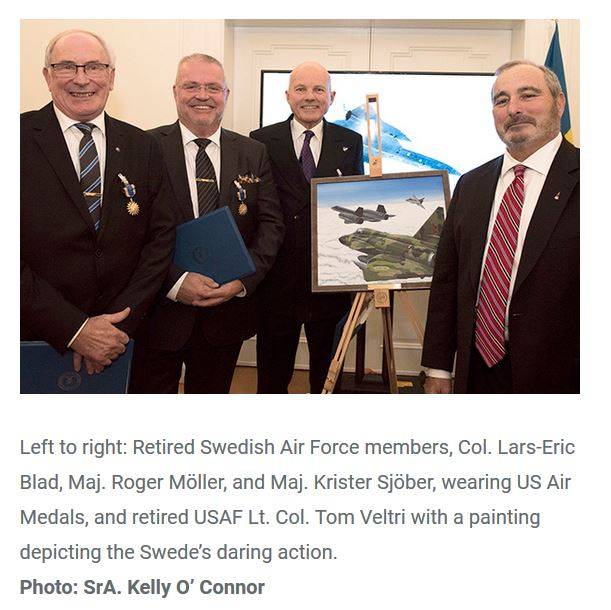
There are only three Swedish pilots in the picture, but everything is fine with the fourth one - he is on an expedition in Canada (ha ha) and participates in the award ceremony remotely, via video link.
Soft. Interception
Now back to the Soviet Far North and Major M. Myagky, who made 1984 successful SR-1987 interceptions between 14 and 71.
Exactly the same text, almost word for word, can be found on the pages of theaviationgeekclub.com, so I don’t know who should be given priority here. I also cannot say why the major's memoirs appeared in the English-language press, and not here. I hope I just didn't find them.
The major, and then still a captain, had previously flown Su-9 and MiG-23, flew 600 hours, was selected for retraining on the MiG-31, and in October 1983 arrived at the 174th GIAP in Monchegorsk. The regiment had already flown the MiG-18 for 31 months and often tried to intercept the SR-71.
A month later, Myagky was sent to the Combat Training Center at the Savasleika airbase, where retraining took place. In July of the following year, he already took up combat duty.
He made his first flight against the SR-71 on August 21, 1984.
According to his recollections, the speed and altitude at which the Drozdy flew simply mesmerized everyone, and the successful interception of the impudent was the highest priority not only for the regiment, but for the entire 10th Air Defense Army.
The signal about the imminent appearance of the SR-71 was given by the guidance station on the Rybachy Peninsula, and the interceptors took off from all airfields where the weather allowed. The zone of responsibility of the 174th regiment was the border sector from Kharlovka to Cape Svyatoy Nos.
Exactly 16 minutes had to pass from the moment of the alarm to the command to take off, of which 2 minutes were allotted for dressing, 2 minutes to run to the plane, sit down and buckle up, and the remaining time to check instruments and taxi to the start.
Technicians first ran to the plane and removed the P60 missiles, since at speeds over 1,75 Mach they would still be blocked.
Preparations for the flight began immediately two crews. Everything had to be done quickly and accurately.
For example, if the ground power plug was pulled out sharply, the navigation system could fail. The crew that reported readiness first will be the first to take off, and the second will be a spare.
The interception scheme was worked out to the second, and the slightest delay threatened with great consequences. During this 16-minute period, the guidance station had already determined which route the SR-71 would follow: forward or reverse.
During the flight to intercept Drozd, many established rules were violated.
For example, the takeoff was made in a northerly direction, although they usually took off in the opposite direction. Some restrictions were removed: the transition to supersonic took place at 8 m instead of 000.
Information about the possible imminent appearance of the SR-71 came from the radio interception service, which listened to the conversations of the tanker crews. If a tanker appeared off the Norwegian coast, this meant that the spy had been in the air for three hours.
The interception took place using only the infrared guidance channel using the OMV - a “multifunctional optical direction finder”, which was hidden in the fuselage in the non-working position. He could detect the SR-71 at a distance of up to 120 km, thanks to the thermal radiation of its engines, and gave target designation to the guidance system. And most importantly - he worked in a passive mode, and the onboard MiG locator did not turn on.
Here is what the major tells about the eighth interception, which he remembered for the fact that he not only caught the bird in the scope, but was also able to examine it.
At about 11:00 a signal was received to take off to intercept the SR-71.
First a shrill bell rang, and then an announcement over the loudspeaker.
The appearance of the SR-71 was always accompanied by nervousness, everyone began to run, fuss and react too emotionally.
I ran to put on my helmet and flight jacket with a harness, and then ran 60 m to the plane.
On that day, I did not fly with my usual weapon operator, but with Alexei Parshin, the squadron operator.
When I sat down in the chair and buckled up, the navigation system's ready lights were already on. I pressed the engine start button, reported readiness to the command post and immediately received instructions to taxi to the starting position.
We stayed there for about five minutes, and my operator "recited a prayer" - as we called the pre-flight checklist.
After the command to take off, we turned on the afterburner and took off.
Takeoff speed was 360 km / h. Without turning off the afterburner, we continued to climb with a roll of about 60 degrees and lay down on a heading of 100. At 8 m we switched to level flight and crossed the sound barrier.
Here the Gremlikha station began to guide us.
We continued to accelerate and climb, and at 16 we already had 000 M, after which we turned into a combat course of 2,3 degrees.
The operator extended and turned on the OMB, and five seconds later the target was captured, and the affected area appeared on the indicator on the windshield.
A pleasant female voice in the headphones announced "Attack".
SR-71 was on a return course, east to west.
As usual, we started aiming at 16, gradually moving up to 000.
Close to 60 km, I noticed a contrail from SR-71 on a crossing course.
I gave the bearing to my operator so that he also looked. A contrail at an altitude of 22-23 km can be seen very rarely, but on this day the weather was excellent.
I passed under the spy, he was 3–000 meters above us, and I could even see his black silhouette.
The SR-71 flew over the ocean, carefully keeping a distance of 60 km from the coastline.
I informed the command post that we were breaking contact, and turned off the afterburner.
We were in the air (at this point) 15 min 40 sec.
The Blackbird was flying its usual route over neutral waters, so there was no point in pursuing it any further.
The guidance station gave us a course for the airfield, we descended to 15, slowed down to 000 M, switched to level flight and turned on the stopwatch.
This was the so-called "lantern cooling zone".
At speeds above 2 M, the skin, including the lantern, heated up to 800 degrees, and if this mode was not maintained, the lantern could crack and even collapse.
Then we descended and slowed down as usual, and landed without incident.
The entire flight lasted 54 minutes.
While we were on the combat course, the reserve crew was in the plane with the engines running.
This was the only time in my 14 intercepts that I saw the SR-71 with my own eyes."
So the Swedes were not the only ones who could bring down Drozd.
And what about the American pilots, have they really never noticed anything?
There is no information in the book about what they knew about the persistent attempts of the stubborn Swedes.
As for the Soviet MiGs… the author of the book has done research and believes that the two interceptions of Major Myagky, who was then the captain, coincide in time with the flights of Lieutenant Colonel Ed Yeilding, who was then a major.
What did you see on the other side?
Let's look at what is happening from the other side.
Since Ed gave a very colorful description of the flights, I will start quoting him from afar.
We flew along the edge of the territorial waters of the USSR to the Kanin Peninsula.
We are very proud of these tasks. We knew that the USSR was a potential enemy of the free world, and keeping an eye on its military activity was a very important task.
We were given a route and targets for our cameras and sensors, but we were never told which of our intelligence agencies was interested in these things.
I think the main interest was in the images of submarines in ports and the missiles with nuclear warheads that were loaded into them.
In addition, we recorded all types of electromagnetic radiation on our route.
The flight started from Mildenehall base in England. Our crews were there on a 6-week basis, and we flew not only to the Barents Sea, but also to other areas.
The takeoff was at half load and minimal fuel, after which we immediately rendezvoused with the tanker and refueled.”
Our VHF radios were encrypted and gave us automatic bearing and range without the need for voice exchange.
After docking, we were able to communicate with the crew of the tanker via the internal intercom system.
Refueling required great attention and care, especially in conditions of severe turbulence. As you fill tanks we were approaching the “stall moment” at full load, so we had to carefully work with the thrust of the engines.
After refueling, we switched to supersonic.
To do this, we ascended to 33 feet at Mach 000 and began a gentle descent. There was a little resistance as you approached M0,9 and then you suddenly stepped over the barrier.
The aircraft was designed for continuous supersonic flight, so no noise or vibration was felt.
After leveling out at 30, I enjoyed looking through the periscope at our contrail, which looked like a rollercoaster.
Then we turned north, climbed up to 71 and accelerated to M000.
Off the northeast coast of Norway, we again descended for a second refueling, this area was informally called "Northern Viking".
Major Soft recalls that just this event was tracked by our radio intelligence and served as an indication that the SR-71 would soon appear at the borders.
The aircraft was designed for the most economical mode at Mach 3,2 and high altitude, but our missions in the Barents Sea are limited to Mach 3 and a maximum bank of 32 degrees.
The turning radius at this speed and with this bank was about 80 miles, and a 90-degree turn took almost 4 minutes.
When information gathering began, we always turned on the autopilot to keep the plane as level as possible. The autopilot was programmed to maintain a certain minimum pitch, so I constantly corrected it with a small yoke on the right panel and careful movements of the thrust control. At that time, autopilots did not have the ability to maintain accurate speed.
Waypoints and turn-on points were loaded into the autopilot on the ground using magnetic tape. In flight, the autopilot received data from the astro-inertial navigation system and kept the course very accurately.
In case of a failure, I could maintain the course manually by keeping the deviation indicator in the center of a given band on the indicator, but this happened very rarely.
There was no GPS system at that time, but we had a small telescope behind the Reconnaissance Equipment Operator (RSO) seat that automatically tracked the correct stars and gave corrections to the astro-navigation system.
I will never forget my first visit to this place in December 1984. We had just rounded Norway's northernmost bulge at 72 degrees latitude, heading east, when I turned my head 90 degrees to the left and looked straight north.
In the ominous December twilight, I was surprised to see the Moon just above the horizon.
Having lived most of my life in relatively low latitudes, I knew for sure that the Moon appeared in the east.
Naturally, I thought: what is this, the east there?
So we're flying south, straight to Russia?
My magnetic compass showed only a 15-degree deviation from the course, which I was very pleased with.
But still, to be completely sure, I asked Steve, my RSO, if he sees the right stars.
He answered in the affirmative, and I calmed down.
It was only later, when I thought about it again, that I realized that in December the earth's axis deviated from the direction of the Sun and leaned towards the Moon, and in conjunction with the high geographical latitude and our height of 73 feet, I was able to look over the top of the Earth and see the Moon on the other side.
Although the Barents Sea lies almost entirely within the Arctic Circle, even in December we could often see the sun just above the horizon from high altitude.
Our route often forced us to cross the terminator line, and one day in late December we crossed the terminator six times, watching sunsets and sunrises almost continuously.
All of our flights were classified, so I didn't take any notes, and I can't now remember with certainty the day it happened.
However, I am certain that Curt Osterheld was the RSO operator and we only did two tours to Mildenhall with him, so this meeting must have been between 25.08.1986/08.10.1986/14.04.1987 - 07.05.1987/XNUMX/XNUMX or XNUMX/XNUMX/XNUMX - XNUMX/XNUMX/XNUMX.
I think this was the last flight of our first tour, and the flight log records show that we had a 4-hour flight on October 6, 1986.
After about a minute of flight in a northerly direction, we turned 180 degrees and rushed south, to the Russian shores.
The altitude was about 75 feet. From this height, we could observe an area 000 miles in diameter and see the earth's surface slightly curved.
Far ahead, perhaps 100 miles away, I noticed a long, bright white contrail reaching towards us, but much lower.
I knew it had to be a Soviet fighter, possibly a MiG-31, the newest interceptor the Russians had at the time.
I raised the periscope, looked back and saw that we, too, were leaving a well-marked trail, and realized that the Russian was also seeing us.
Since we were flying regular routes, the Russians knew perfectly well the point where we would turn 90 degrees to the right and head west along the coast.
I imagined that the Russian pilot should be like us, with love for aviation and striving to be the very best in what he does.
I also realized that he had orders to fire if I was too late to turn and slip inside the Russian borders, and that there was nothing better for him than to fire missiles at SR-71.
In the 80s we didn't worry too much about missiles, relying on our speed and altitude.
I knew from my previous experience flying the F-4 that the MiG-31 had maneuverability problems at high altitudes and would have difficulty calculating the launch triangle.
We also thought that an air-to-air missile at that altitude and in thin air would have problems with maneuverability and range.
For missiles with a radar homing head, our small reflective surface would be a problem, and besides, we had the ability to jam.
I knew that our contrail would help him point in the right direction, and the heat-headed missiles might take us.
We didn't have protective gear like heat traps, but again we relied on our speed and altitude.
I decided that I would fly the same course.
To survive, we relied on the accuracy of our navigational instruments, which kept us outside the Russian borders, and this made it impossible to fire a rocket at us.
In the event that this does happen, we counted on the capabilities of our aircraft.
I directly felt how he was trying to accelerate in order to jump out to the same height as us, and I looked at the indicator counting the distance to the turn.
The distance decreased by a mile every two seconds.
As always, I was ready to start the turn manually if the autopilot for some reason refused to do so, but this time it obediently turned 90 to the right at the set point.
The turn was programmed with a bank of 32 degrees.
I carefully watched the instruments, ready to react to any malfunction, and at the same time often turned my head, watching the fighter.
From the contrail, I determined that he went up steeply and straight at us.
About a minute after the start of the turn, I saw below, in the direction of 7 o'clock, the gray silhouette of a fighter at the top of its jump.
We were still banked 32 degrees to the right, but I saw it as a very large dot.
I couldn't see any features like the twin fins, but from my experience with F-4 interceptions, the minimum distance to the fighter was about 8 miles, and its height was probably somewhere around 65 feet - then is about 000 below us.
It seems that at this point he lost speed, his nose dropped below the horizon, and he went down.
But only on that day, far beyond the Arctic Circle, over the Barents Sea, I saw a metal hull, albeit barely noticeable, and even then only because our route was completely predictable.
End of quote.
It is a pity that our pilots do not write memoirs, and such interesting events have to be looked for in English-language literature.
Here is such an excursion into history. I was interested, and I hope you are too.
Sources:
1. https://www.hotcars.com/how-saabs-viggen-fighter-almost-took-down-legendary-sr-71-blackbird
2. https://nationalinterest.org/blog/reboot/country-almost-shot-down-sr-71-blackbird-199482
3. https://www.hotcars.com/how-saabs-viggen-fighter-almost-took-down-legendary-sr-71-blackbird
4. https://www.airforcemag.com/article/saving-a-blackbird
5. https://nationalinterest.org/blog/buzz/cold-war-showdown-swedish-ja-37-viggen-vs-sr-71-blackbird-66156
6. https://theaviationgeekclub.com/ja-37-viggen-pilot-explains-how-he-was-able-to-carry-out-the-first-successful-swedish-air-force-intercept-of- an-sr-71-mach-3-spy-plane-over-the-baltic
7. https://www.historynet.com/unstart-over-murmansk.htm
8. https://www.airforcetimes.com/news/your-air-force/2018/12/30/finally-declassified-swedish-pilots-awarded-us-air-medals-for-saving-sr-71-spy-plane
9. Graham R. Flying the SR-71 Blackbird: In the Cockpit on a Secret Operational Mission
10. Paul F. Crickmore. Lockheed SR-71 Operations in Europe and the Middle East

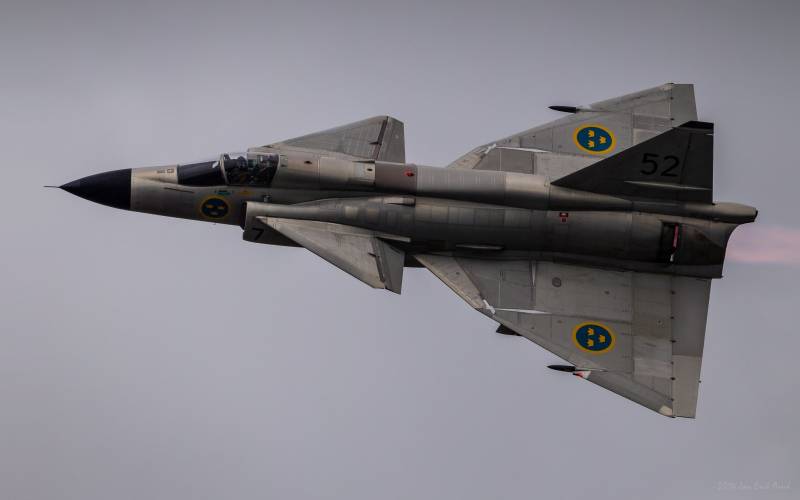
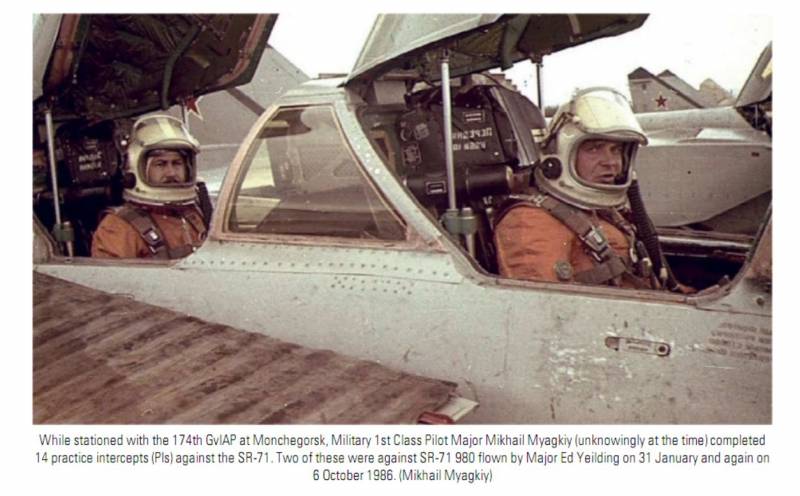
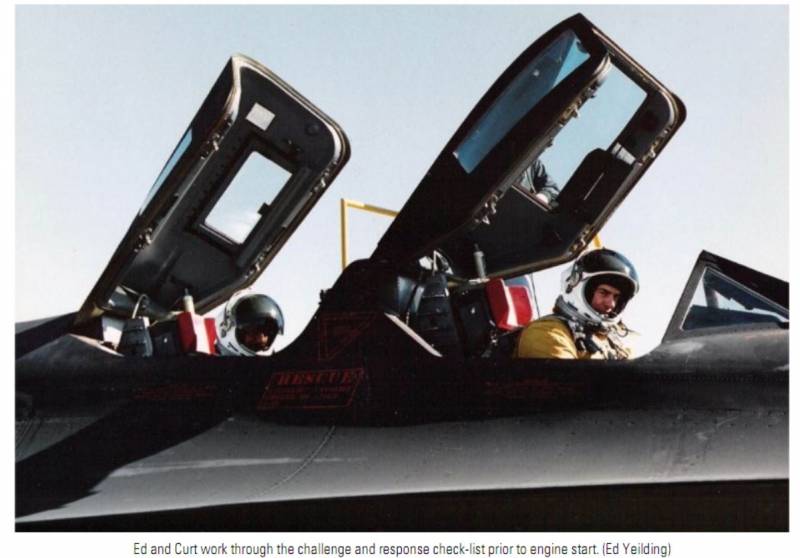
Information